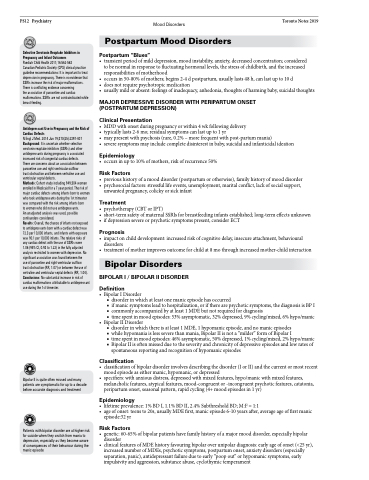Page 1176 - TNFlipTest
P. 1176
PS12 Psychiatry
Selective Serotonin Reuptake Inhibitors in Pregnancy and Infant Outcomes
Paediatr Child Health 2011;16:562-563
Canadian Pediatric Society (CPS) clinical practice guideline recommendations: It is important to treat depression in pregnancy. There is no evidence that SSRIs increase the risk of major malformations. There is conflicting evidence concerning
the association of paroxetine and cardiac malformations. SSRIs are not contraindicated while breast-feeding.
Antidepressant Use in Pregnancy and the Risk of Cardiac Defects
N Engl J Med. 2014 Jun 19;370(25):2397-407 Background: It is uncertain whether selective serotonin-reuptake inhibitors (SSRIs) and other antidepressants during pregnancy is associated increased risk of congenital cardiac defects.
There are concerns about an association between paroxetine use and right ventricular outflow
tract obstruction and between sertraline use and ventricular septal defects.
Methods: Cohort study including 949,504 women enrolled in Medicaid for a 7 year period. The risk of major cardiac defects among infants born to women who took antidepressants during the 1st trimester was compared with the risk among infants born
to women who did not use antidepressants.
An unadjusted analysis was used, possible confounders considered.
Results: Overall, the chance of infants not exposed to antidepressants born with a cardiac defect was 72.3 per 10,000 infants, and infants with exposure was 90.1 per 10,000 infants. The relative risks of any cardiac defect with the use of SSRIs were 1.06 (95% CI, 0.93 to 1.22) in the fully adjusted analysis restricted to women with depression. No significant association was found between the
use of paroxetine and right ventricular outflow
tract obstruction (RR, 1.07) or between the use of sertraline and ventricular septal defects (RR, 1.04). Conclusions: No substantial increase in risk of cardiac malformations attributable to antidepressant use during the 1st trimester.
Mood Disorders Toronto Notes 2019 Postpartum Mood Disorders
Postpartum “Blues”
• transientperiodofmilddepression,moodinstability,anxiety,decreasedconcentration;considered to be normal in response to fluctuating hormonal levels, the stress of childbirth, and the increased responsibilities of motherhood
• occursin50-80%ofmothers;begins2-4dpostpartum,usuallylasts48h,canlastupto10d
• doesnotrequirepsychotropicmedication
• usuallymildorabsent:feelingsofinadequacy,anhedonia,thoughtsofharmingbaby,suicidalthoughts
MAJOR DEPRESSIVE DISORDER WITH PERIPARTUM ONSET (POSTPARTUM DEPRESSION)
Clinical Presentation
• MDDwithonsetduringpregnancyorwithin4wkfollowingdelivery
• typicallylasts2-6mo;residualsymptomscanlastupto1yr
• may present with psychosis (rare, 0.2% – more frequent with post-partum mania)
• severe symptoms may include complete disinterest in baby, suicidal and infanticidal ideation
Epidemiology
• occursinupto10%ofmothers,riskofrecurrence50%
Risk Factors
• previoushistoryofamooddisorder(postpartumorotherwise),familyhistoryofmooddisorder • psychosocialfactors:stressfullifeevents,unemployment,maritalconflict,lackofsocialsupport,
unwanted pregnancy, colicky or sick infant
Treatment
• psychotherapy(CBTorIPT)
• short-termsafetyofmaternalSSRIsforbreastfeedinginfantsestablished;long-termeffectsunknown • ifdepressionsevereorpsychoticsymptomspresent,considerECT
Prognosis
• impact on child development: increased risk of cognitive delay, insecure attachment, behavioural disorders
• treatmentofmotherimprovesoutcomeforchildat8mothroughincreasedmother-childinteraction
Bipolar Disorders
BIPOLAR I / BIPOLAR II DISORDER
Definition
• BipolarIDisorder
■ disorder in which at least one manic episode has occurred
■ if manic symptoms lead to hospitalization, or if there are psychotic symptoms, the diagnosis is BP I ■ commonly accompanied by at least 1 MDE but not required for diagnosis
■ timespentinmoodepisodes:53%asymptomatic,32%depressed,9%cycling/mixed,6%hypo/manic
• BipolarIIDisorder
■ disorder in which there is at least 1 MDE, 1 hypomanic episode, and no manic episodes
■ while hypomania is less severe than mania, Bipolar II is not a “milder” form of Bipolar I
■ timespentinmoodepisodes:46%asymptomatic,50%depressed,1%cycling/mixed,2%hypo/manic ■ Bipolar II is often missed due to the severity and chronicity of depressive episodes and low rates of
spontaneous reporting and recognition of hypomanic episodes
Classification
• classificationofbipolardisorderinvolvesdescribingthedisorder(IorII)andthecurrentormostrecent mood episode as either manic, hypomanic, or depressed
• specifiers:withanxiousdistress,depressedwithmixedfeatures,hypo/manicwithmixedfeatures, melancholic features, atypical features, mood-congruent or -incongruent psychotic features, catatonia, peripartum onset, seasonal pattern, rapid cycling (4+ mood episodes in 1 yr)
Epidemiology
• lifetimeprevalence:1%BDI,1.1%BDII,2.4%SubthresholdBD;M:F=1:1
• ageofonset:teensto20s,usuallyMDEfirst,manicepisode6-10yearsafter,averageageoffirstmanic
episode:32 yr
Risk Factors
• genetic:60-65%ofbipolarpatientshavefamilyhistoryofamajormooddisorder,especiallybipolar disorder
• clinical features of MDE history favouring bipolar over unipolar diagnosis: early age of onset (<25 yr), increased number of MDEs, psychotic symptoms, postpartum onset, anxiety disorders (especially separation, panic), antidepressant failure due to early “poop out” or hypomanic symptoms, early impulsivity and aggression, substance abuse, cyclothymic temperament
Bipolar II is quite often missed and many patients are symptomatic for up to a decade before accurate diagnosis and treatment
Patients with bipolar disorder are at higher risk for suicide when they switch from mania to depression, especially as they become aware of consequences of their behaviour during the manic episode


